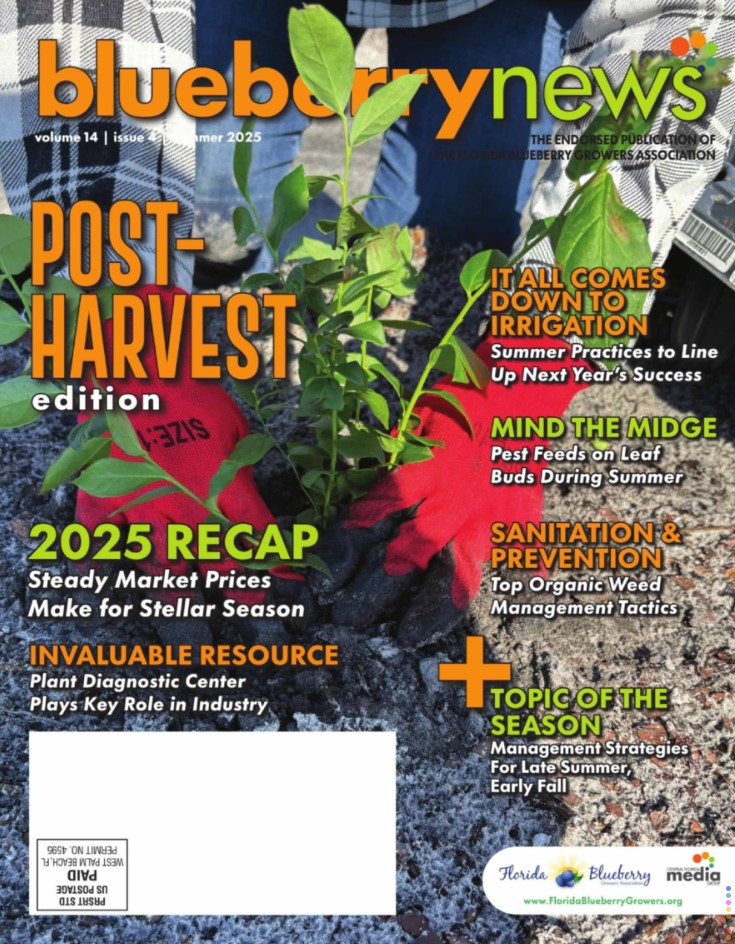Late Summer and Early Fall Are Prime Times for Southern Red Mite
The southern red mite is the most important mite pest attacking blueberry plants in Florida. Adults are about 1/60 of an inch in length, red or brown to deep purple in color, with lighter-colored legs. Females are slightly larger than males and have a more rounded body shape, compared to the slender body of the males (Figure 1).
Figure 1. Southern red mite adult female and male mating, and one egg.
Credit: L. Buss, UF/IFAS
In southern highbush blueberries (SHB), southern red mites primarily populate the underside of leaves, feeding on plant tissues by inserting their mouthparts into the leaf and removing cell contents. This creates bronzing of the leaves (Figure 2), which is the primary symptom associated with this pest and decreases the rate of photosynthesis. Another indication of red mite infestation is an accumulation of white shed skins on the underside of leaves when populations are high (Figure 3). Shed skins may also be a sign that mites recently invaded that section of the planting and that there is potential for mite outbreaks in adjacent blocks if not monitored or managed carefully.
Figure 2. Characteristic bronze-colored blueberry leaves associated with southern red mite damage.
Credit: D. Phillips, UF/IFAS
Figure 3. Southern red mite shed skins.
Credit: D. Phillips, UF/IFAS
Southern red mite populations increase when temperatures are between 60°F and 86°F, reaching high numbers during hot, dry fall months. Their life cycle can be completed within two weeks under these conditions. They are typically found in Florida SHB plantings in late August or early September, with increased mite populations observed at the beginning of October, continuing through fall and winter months in evergreen systems.
Effective management of this pest begins with frequent scouting for the presence of adult mites and feeding symptoms. Southern red mites can be seen with a 10x hand lens and collection of leaves during vegetative growth beginning in late summer is recommended to identify early mite infestations. Closely examine the underside of leaves with a magnifying glass and look for adults, shed skins, and webbing. Characteristic symptoms of mite feeding such as bronzed leaves are also a good indication of mite infestations. However, these symptoms usually appear when mite populations are already at high levels.
Three miticides, Magister® with the active ingredient fenazaquin, Portal® with the active ingredient fenpyroximate, and Kanemite® with the active ingredient acequinocyl are registered for use in highbush blueberries. These miticides target tetranychids and not specifically southern red mites. The miticides control all developmental stages (larvae, nymphs, and adults) of southern red mites. In 2019 UF field trials, Magister® and Portal® were the best-performing miticides for suppressing southern red mite populations and allowing bushes to recover from mite injury. Growers can only make one application per year using Magister® and two applications per year with Portal®. Early identification of mite infestations and implementation of management techniques (during August and September) before mites reach high population numbers are recommended to avoid impacts to plant yields the following season.
Dusty conditions are favorable for mites, and drought-stressed plants can be more susceptible to infestations. Water should be regularly applied to roadways or other dusty areas during hot, dry periods along with sufficient plant irrigation to avoid drought stress, which is particularly important during periods of mite activity.
CREDIT
Dr. OSCAR LIBURD, Professor, UF/IFAS
& DOUG PHILLIPS, Blueberry Extension Coordinator, UF/IFAS





